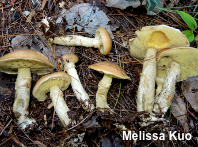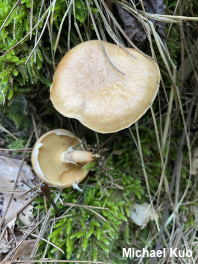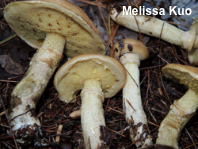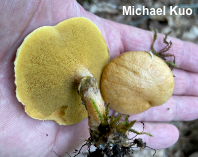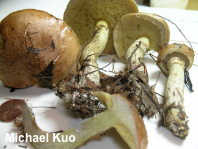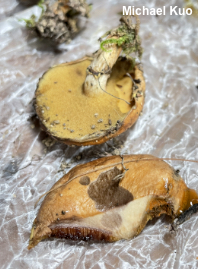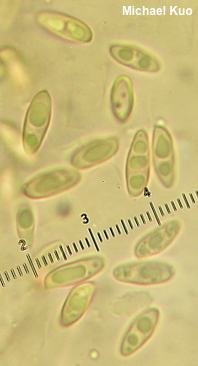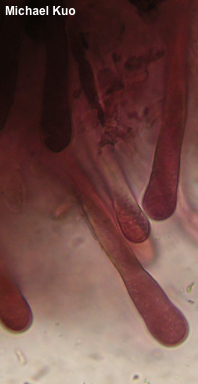| Major Groups > Boletes > Suillus > Suillus subalutaceus |

|
[ Basidiomycota > Boletales > Suillaceae > Suillus . . . ] Suillus subalutaceus by Michael Kuo, 18 October 2022 Associated with red pine throughout the natural and planted range of the tree, Suillus subalutaceus features a cap that changes from yellow to cinnamon brown with development. Its tough stem features a collapsing ring, and its flesh is whitish to pale yellow, even in the stem. The taste of the slime on the cap (unfortunately this is a feature that helps with identification) is mild rather than acidic or acrid. Suillus acidus is very similar, and also often associated with red pine, but its cap does not become cinnamon brown, the flesh in its stem is pinkish orange, and the taste of the slime on its cap is acidic. Description: Ecology: Mycorrhizal with red pine; growing alone, scattered, or gregariously; late summer and fall; originally described from Michigan (Smith & Thiers 1964); distributed in the northern Midwest and northeastern North America, south into the Appalachian Mountains. The illustrated and described collections are from Kentucky and Ohio. Cap: 3.5–7 cm; convex at first, becoming broadly convex; sticky to slimy when fresh; innately and sparsely fibrillose; yellow when young, maturing to dull orangish brown or cinnamon brown; often featuring white partial veil remnants on the margin. Pore Surface: Yellow, becoming brownish yellow; not bruising; pores round to angular, about 2–3 per mm; tubes to 8 mm deep. Stem: 5–8 cm long; 0.5–1.5 cm thick; tough; equal; yellow and bald at the apex; whitish to yellowish below, with brown glandular dots; with a thin whitish ring that is often a little gelatinized at first, and later collapses against the stem, becoming grayish to brownish; basal mycelium white. Flesh: Whitish to pale yellow or slightly orangish (but not dark pinkish orange); not staining on exposure. Odor and Taste: Odor not distinctive; taste of flesh not distinctive; taste of cap slime mild, not acrid. Chemical Reactions: Ammonia negative on cap surface; negative on flesh. KOH dark gray on cap surface; gray on flesh. Iron salts negative on cap surface; negative on flesh. Spore Print: Cinnamon brown. Microscopic Features: Spores 7–11 x 3–4 µm; boletoid-fusiform; smooth; yellowish in KOH. Basidia 22–25 x 3–4 µm; clavate; 4-sterigmate. Cystidia in gelatinized bundles, often poorly defined individually; 45–70 x 5–8; cylindric to clavate; thin-walled; smooth; brownish purple in KOH. Pileipellis an ixocutis of elements 2–4 µm wide, smooth, hyaline to yellowish in KOH. REFERENCES: (A. H. Smith & H. D. Thiers, 1964) A. H. Smith & H. D. Thiers, 1971. (Grund & Harrison, 1976; Both, 1993; Bessette, Roody & Bessette, 2000; McNeil, 2006; Nguyen et al., 2016.) Herb. Kuo 10051505, 08262201. This site contains no information about the edibility or toxicity of mushrooms. |
© MushroomExpert.Com |
|
Cite this page as: Kuo, M. (2022, October). Suillus subalutaceus. Retrieved from the MushroomExpert.Com Web site: http://www.mushroomexpert.com/suillus_subalutaceus.html |
